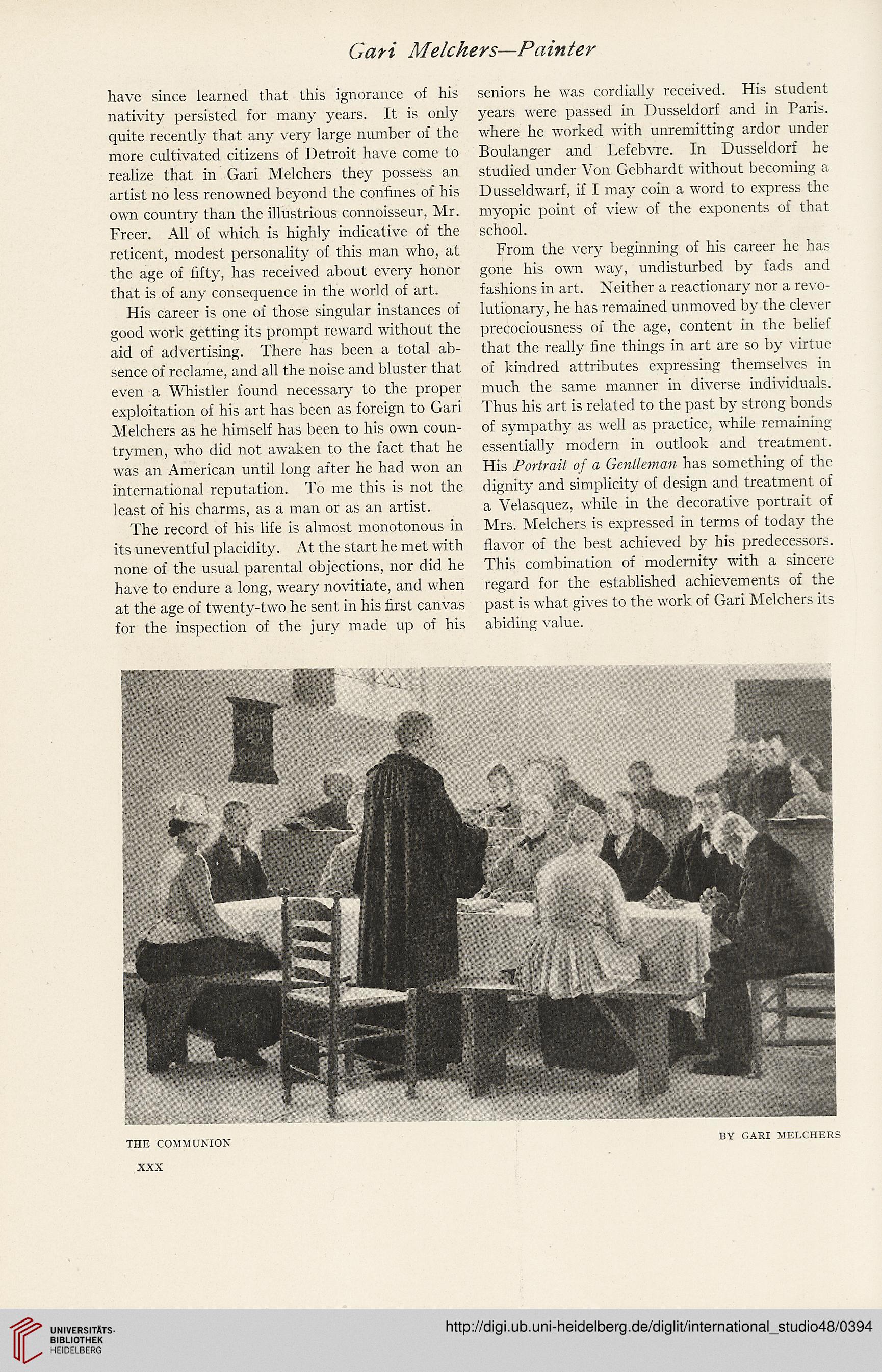Gari Melchers—Painter
have since learned that this ignorance of his
nativity persisted for many years. It is only
quite recently that any very large number of the
more cultivated citizens of Detroit have come to
realize that in Gari Melchers they possess an
artist no less renowned beyond the confines of his
own country than the illustrious connoisseur, Mr.
Freer. All of which is highly indicative of the
reticent, modest personality of this man who, at
the age of fifty, has received about every honor
that is of any consequence in the world of art.
His career is one of those singular instances of
good w’ork getting its prompt reward without the
aid of advertising. There has been a total ab-
sence of reclame, and all the noise and bluster that
even a Whistler found necessary to the proper
exploitation of his art has been as foreign to Gari
Melchers as he himself has been to his own coun-
trymen, who did not awaken to the fact that he
was an American until long after he had won an
international reputation. To me this is not the
least of his charms, as a man or as an artist.
The record of his life is almost monotonous in
its uneventful placidity. At the start he met with
none of the usual parental objections, nor did he
have to endure a long, weary novitiate, and when
at the age of twenty-two he sent in his first canvas
for the inspection of the jury made up of his
seniors he was cordially received. His student
years were passed in Dusseldorf and in Paris,
where he worked with unremitting ardor under
Boulanger and Lefebvre. In Dusseldorf he
studied under Von Gebhardt without becoming a
Dusseldwarf, if I may coin a word to express the
myopic point of view of the exponents of that
school.
From the very beginning of his career he has
gone his own way, undisturbed by fads and
fashions in art. Neither a reactionary nor a revo-
lutionary, he has remained unmoved by the clever
precociousness of the age, content in the belief
that the really fine things in art are so by virtue
of kindred attributes expressing themselves in
much the same manner in diverse individuals.
Thus his art is related to the past by strong bonds
of sympathy as well as practice, while remaining
essentially modern in outlook and treatment.
His Portrait of a Gentleman has something of the
dignity and simplicity of design and treatment of
a Velasquez, while in the decorative portrait of
Mrs. Melchers is expressed in terms of today the
flavor of the best achieved by his predecessors.
This combination of modernity with a sincere
regard for the established achievements of the
past is what gives to the work of Gari Melchers its
abiding value.
THE COMMUNION BY GARI MELCHERS
XXX
have since learned that this ignorance of his
nativity persisted for many years. It is only
quite recently that any very large number of the
more cultivated citizens of Detroit have come to
realize that in Gari Melchers they possess an
artist no less renowned beyond the confines of his
own country than the illustrious connoisseur, Mr.
Freer. All of which is highly indicative of the
reticent, modest personality of this man who, at
the age of fifty, has received about every honor
that is of any consequence in the world of art.
His career is one of those singular instances of
good w’ork getting its prompt reward without the
aid of advertising. There has been a total ab-
sence of reclame, and all the noise and bluster that
even a Whistler found necessary to the proper
exploitation of his art has been as foreign to Gari
Melchers as he himself has been to his own coun-
trymen, who did not awaken to the fact that he
was an American until long after he had won an
international reputation. To me this is not the
least of his charms, as a man or as an artist.
The record of his life is almost monotonous in
its uneventful placidity. At the start he met with
none of the usual parental objections, nor did he
have to endure a long, weary novitiate, and when
at the age of twenty-two he sent in his first canvas
for the inspection of the jury made up of his
seniors he was cordially received. His student
years were passed in Dusseldorf and in Paris,
where he worked with unremitting ardor under
Boulanger and Lefebvre. In Dusseldorf he
studied under Von Gebhardt without becoming a
Dusseldwarf, if I may coin a word to express the
myopic point of view of the exponents of that
school.
From the very beginning of his career he has
gone his own way, undisturbed by fads and
fashions in art. Neither a reactionary nor a revo-
lutionary, he has remained unmoved by the clever
precociousness of the age, content in the belief
that the really fine things in art are so by virtue
of kindred attributes expressing themselves in
much the same manner in diverse individuals.
Thus his art is related to the past by strong bonds
of sympathy as well as practice, while remaining
essentially modern in outlook and treatment.
His Portrait of a Gentleman has something of the
dignity and simplicity of design and treatment of
a Velasquez, while in the decorative portrait of
Mrs. Melchers is expressed in terms of today the
flavor of the best achieved by his predecessors.
This combination of modernity with a sincere
regard for the established achievements of the
past is what gives to the work of Gari Melchers its
abiding value.
THE COMMUNION BY GARI MELCHERS
XXX




